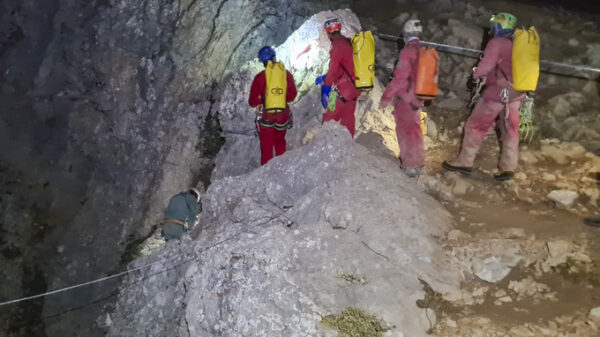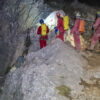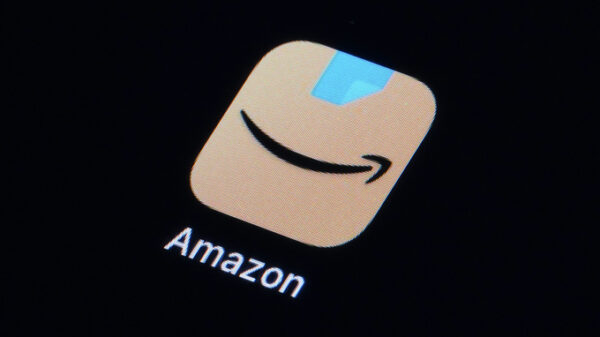An NYSE sign is seen on the floor at the New York Stock Exchange in New York, Wednesday, June 15, 2022. Wall Street got back to selling on Thursday, reversing course a day after a climbing on hopes that the Federal Reserve’s huge interest rate hike it made this week won’t be a common practice in its ongoing fight against inflation. Stocks were opening sharply lower, sending the S&P 500 down 2.7%, and Treasury yields were moving higher again. (AP Photo/Seth Wenig)
NEW YORK (AP) — Markets worldwide are back to tumbling on Thursday, and Wall Street is down close to 3% in a nearly total wipeout as worries about a fragile economy roar back to the fore.
The S&P 500 was 2.8% lower in early trading, more than reversing its blip of a 1.5% rally from a day before. Analysts had warned of more big swings given deep uncertainties about whether the Federal Reserve and other central banks can tiptoe the narrow path of hiking interest rates enough to slow high inflation but not so much that they cause a recession.
The Dow Jones Industrial Average was down 685 points, or 2.2%, at 29,983, shortly after 10 a.m. Eastern time, and the Nasdaq composite was 3.4% lower. The S&P 500 was on track for its sixth loss in the last seven days, and all but four of the 500 companies in the index were lower.
Wall Street fell with stocks across Europe after central banks there followed up on the Federal Reserve’s interest-rate hike on Wednesday. The Bank of England raised its key rate for the fifth time since December, though it opted for a more modest 0.25 percentage points than the 0.75-point hammer brought by the Fed.
Switzerland’s central bank, meanwhile, raised rates for the first time in years, a half-point hike. Taiwan’s central bank raised its key rate by an eighth of a point.
“The clear read-through here is the FOMC (Fed) has unleashed the central bank Hawkish Genie from the bottle, and we should expect more aggressive follow-through from other central banks except those who are economically challenged,” Stephen Innes of SPI Asset Management said in a commentary.
Such moves and expectations for plenty more around the world have sent all kinds of investments tumbling this year, from bonds to bitcoin. Higher interest rates slow the economy by design, in hopes of stamping out inflation. But they’re a blunt tool that can choke off the economy if used too aggressively.
Not only is the Federal Reserve hiking short-term rates, it also this month has begun allowing some of the trillions of dollars of bonds that it purchased through the pandemic to roll off its balance sheet. That should put upward pressure on longer-term interest rates.
The U.S. economy is still largely holding up, driven in particular by a red-hot jobs market. But more signs of trouble have been emerging.
On Thursday, one report showed homebuilders broke ground on fewer homes last month. Rising mortgage rates resulting directly from the Fed’s moves are digging into the industry. A separate reading on manufacturing in the mid-Atlantic region also unexpectedly fell.
More economists are considering the possibility of a U.S. recession. At Deutsche Bank, economists have in recent months moved up their forecast for when a recession may hit. They see it occurring around mid 2023.
Treasury yields got back to climbing Thursday, with the 10-year yield rising to 3.42% from 3.39%. Earlier this week, it screamed to its highest level since 2011.
Higher rates have been delivering the hardest hits to the investments that soared the most through the pandemic, benefiting from the easy, ultralow rates. That includes bitcoin and high-growh technology stocks.
Losses for Apple, Amazon, Tesla and other big tech-oriented stocks provided the heaviest weights on the S&P 500. Each fell more than 3%.
But the sharpest losses came for stocks whose profits depend more on the strength of the economy and whether customers can keep up their purchases amid the highest inflation in decades.
Cruise operator Carnival fell 8.5%, Capital One Financial dropped 7% and General Motors lost 6.6%.
It’s all a sharp turnaround from a day earlier, when stocks rallied on Wall Street immediately after the Fed’s biggest hike to rates since 1994. Analysts said investors seemed to latch onto a comment from Fed Chair Jerome Powell, who said mega-hikes of three-quarters of a percentage point would not be common.
Powell said Wednesday the Fed is moving “expeditiously” to get rates closer to normal levels after last week’s stunning report that showed inflation at the consumer level unexpectedly accelerated last month, which dashed that inflation may have already peaked.
The Fed is “not trying to induce a recession now, let’s be clear about that,” Powell said. He called Wednesday’s big increase “front-end loading.”
“Despite their assurance, it’s unclear to me whether the Fed has the tools they say they do to tamp down prices,” said Jason Brady, CEO of Thornburg Investment Management. He also said that even after its mega-hike on Wednesday, which was triple the usual amount, “the Fed is still behind.”
AP Business Writer Yuri Kageyama contributed.
Copyright 2021 Associated Press. All rights reserved.










































